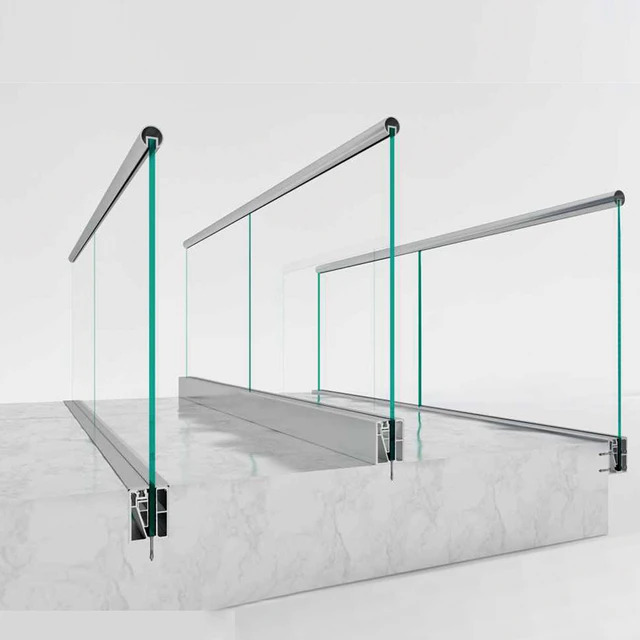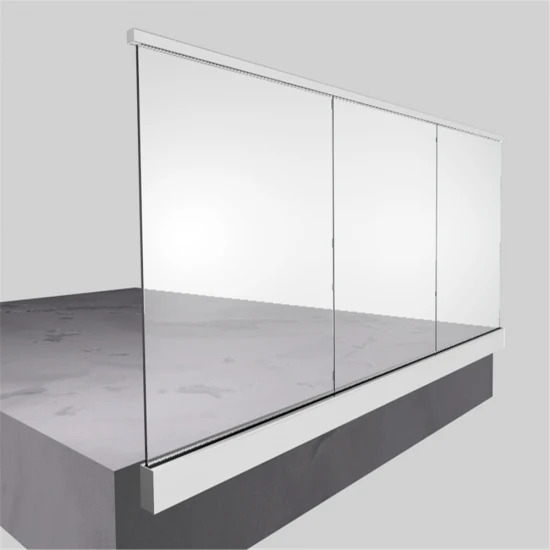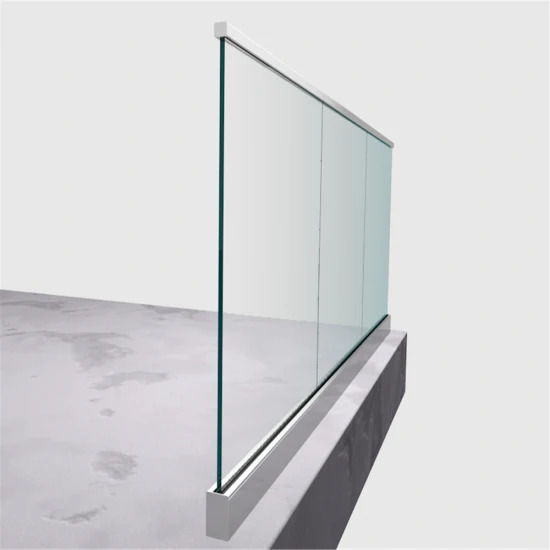Glass is increasingly used in construction to create transparent fencing. It is suitable for indoor and outdoor glass railings, glass swimming pool fences and glass staircase balustrades. Glass combines safety with sleek design. However, installation requires specific skills. The glass must be securely fixed in place, while maintaining its transparent appearance.

Glass balustrade fastenings for indoor and outdoor use
The "English" method of fastening is the most conventional for installingRailing-glass.com indoor and outdoor glass railings .
How it works
The installation of an interior or exterior glass balustrade using the "English" fixing method relies on the use of aluminum profiles that completely encircle the glass panel. These profiles are specially designed to receive the glass and ensure its solid attachment.
The glass panel is precisely inserted into a frame formed by the side-by-side profiles. This allows the glass to be perfectly guided and positioned. Plastic or foam spacers are usually placed between the glass and the profiles to prevent direct contact and protect the transparent surface.
Once in place, the glass panel is securely fastened to the profiles using bolts, cleats or screws. These clamps are evenly distributed along the length of the profiles. They exert a uniform pressure on the aluminum frame to permanently immobilize the glass railing.
High strength and transparency
This solution offers high overall strength, while ensuring total transparency of the glass railing. The profiles, which are generally thin, do not obstruct the view through the glass once installation is complete. Profiles can be laid horizontally and vertically to further enhance mechanical safety. This cross-shaped arrangement firmly anchors the glass panel. Alternatively, the profiles can be fitted with silicone or rubber gaskets to ensure a watertight installation. This protects the glass railing from water ingress.
Façade-matched finish
For exterior glass railings installed on facades, thicker anodized profiles are required. They can also be painted to match the color of the facade. This option adds an extra aesthetic touch.
French fastenings for glass balustrades
French" fastening is mainly used to installRailing-glass.com glass balustrades .
Principle of direct fastening
The "French" fixing method works on the principle of direct glass fixing. Metal brackets, generally made of aluminum, are installed at intervals along the length of the balustrade.
These brackets do not exceed the length of the glass panel. They are designed to receive the short edge of the glass panel directly, without the need for peripheral profiles.
The glass panel is then securely fastened to these brackets, either by screwing or gluing. The screwing technique involves drilling precise holes in the short edge of the glass and inserting sealed screws. These tighten the glass against the console. Bonding involves applying a highly resistant structural adhesive between the edge of the glass and the metal bracket.
Uncluttered aesthetics for interiors
The direct attachment of the glass to short brackets, without the need for a peripheral profile, gives the glass balustrade a clean, uncluttered look. The total absence of any frame around the glass gives the balustrade a remarkably light, transparent appearance.
The presence of the brackets is barely noticeable, thanks to their small size, no longer than the length of the glass panel. The unobtrusiveness of the fasteners creates a visual impression of uninterrupted, floating glass.
This French-style fastening method is therefore particularly suitable for indoor installations, especially for staircase glass balustrades. The effect of total transparency created by the absence of profiles fits perfectly with the interior environment. It adds a touch of modern design.
Qualified technician and personalized support for glass fencing installation
Regardless of the fastening technique chosen, the installation of a transparent glass fence requires a high level of expertise and skill.
Call on a qualified professional
Installing a glass fence is a delicate operation. It requires specific skills, particularly for :
- the precise cutting and drilling of the glass;
- the choice of suitable fixing accessories;
- the rigorous installation according to the rules of the trade.
You need to call on a specialized professional, preferably one with RGE (Reconnu Garant de l'Environnement) certification. A qualified technician has undergone in-depth training, enabling him or her to master every stage of the project.
His long experience in the field also gives him a perfect understanding of the technical and regulatory constraints involved in installing glass structures, including safety requirements. For example, he knows how to determine the right thickness of glass for a given height and location.
Adapting the technical solution
A qualified professional will be able to precisely identify your needs and technical constraints, depending on the nature and location of your glass fencing project. For example, in the case of a glass swimming pool fence, safety requirements linked to the proximity of water will dictate the choice of reinforced, non-flammable glass and extremely resistant fastenings.
In the case of a glass balcony gate, exposure to the elements calls for a certified watertight installation. The installer will also study parameters such as the size of the partition, its exposure, anticipated traffic, etc. to determine the most suitable fastening method (English or French) and accessories.
Expert technical advice
Railing-glass.com 's qualified installers don't limit themselves to the physical installation of glass railings. He is happy to share his technical expertise with his customers. He will provide valuable advice on material selection and installation. This applies to the type of glass best suited to the thickness, transparency or strength required.
He can also explain in detail the steps involved in preparation, cutting, drilling and fixing. If you wish, you can do some of the preparatory work yourself.
Technical data sheets and videos are available to complement these explanations. They explain how to handle and protect the glass during cutting.
Personalized follow-up through to delivery
A qualified installer doesn't abandon his customers once the installation is complete. He provides personalized follow-up throughout the project. He scrupulously checks all fasteners and the perfect fit of the glass during the intermediate phases of installation.
Once the job is complete, he will carry out a detailed inspection of the glass balustrade with you. He takes the time to check, point by point, that the structure complies with standards and is sound.
Mechanical and watertightness tests can be carried out to ensure the long-term performance of the transparent structure. You will then receive a detailed file with photos and a compliance report, attesting to the quality of the service provided. After acceptance, the installer remains available if necessary, for example, to clean the glass or repair any minor cosmetic defects.


